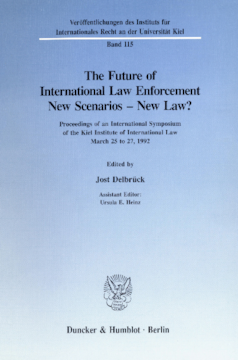The Future of International Law Enforcement. New Scenarios - New Law?

BOOK
Cite BOOK
Style
Format
The Future of International Law Enforcement. New Scenarios - New Law?
Proceedings of an International Symposium of the Kiel Institute of International Law. March 25 to 27, 1992
Editors: Delbrück, Jost
Veröffentlichungen des Walther-Schücking-Instituts für Internationales Recht an der Universität Kiel, Vol. 115
(1993)
Additional Information
Book Details
Pricing
Abstract
Die »Veröffentlichungen des Walther-Schücking-Instituts für Internationales Recht an der Universität Kiel« sind eine 1918 unter dem Namen »Aus dem Institut für Internationales Recht an der Universität Kiel« gegründete Schriftenreihe des ältesten universitären Völkerrechtsinstituts im deutschsprachigen Raum. Sie werden in der Nachfolge von Prof. Dr. Jost Delbrück herausgegeben. In ihr werden zum einen Habilitationsschriften von Institutsangehörigen und hervorragende Dissertationen, die von den Direktorinnen und Direktoren des Instituts betreut oder begutachtet wurden, veröffentlicht. Zum anderen erscheinen in der Schriftenreihe die Tagungsbände der vom Institut ausgerichteten internationalen Symposien und Workshops sowie die Sammelbände zu den jedes Jahr veranstalteten Ringvorlesungen des Instituts. Schließlich finden sonstige Monographien von Institutsangehörigen oder von mit dem Institut verbundenen Wissenschaftlern Aufnahme.
Table of Contents
| Section Title | Page | Action | Price |
|---|---|---|---|
| Foreword | 5 | ||
| Contents | 7 | ||
| Abbreviations | 8 | ||
| Jost Delbrück: Opening Address | 9 | ||
| Rüdiger Wolfrum: Opening Address | 12 | ||
| W. Michael Reisman: New Scenarios of Threats to International Peace and Security: Developing Legal Capacities for Adequate Responses | 13 | ||
| I. Conceptions of Security | 14 | ||
| II. The Need ror International Arrangements | 15 | ||
| III. Proaction and Prosponse | 15 | ||
| IV. Some Moral Implications | 16 | ||
| V. Future Constructs | 17 | ||
| VI. Constructing Threatening Futures | 19 | ||
| VII. Using Futures to Generate Prospective Strategies | 20 | ||
| VIII. Contextualizing Constructive Futures | 21 | ||
| IX. An Example: The Hemorrhaging of Soviet Military Industrial Skills | 22 | ||
| X. Six Constructs of Threats to International Peace and Security | 24 | ||
| XI. First Future Construct: International Institutional Capacity to Respond to Manifest Inclusive Threats | 25 | ||
| XII. Second Future Construct: Nuclear Proliferation and Limited Nuclear War | 28 | ||
| XIII. Third Future Construct: Conventional Aggression | 31 | ||
| XIV. Fourth Future Construct: The Breakdown of the United Nations System | 33 | ||
| XV. Fifth Future Construct: Low-Intensity Warfare | 35 | ||
| XVI. Sixth Future Construct: Non-State Terror | 37 | ||
| Conclusion | 37 | ||
| Tom Farer: The Future of International Law Enforcement under Chapter VII: Is There Room for “New Scenarios”? | 39 | ||
| Alfred P. Rubin: Comment | 57 | ||
| Discussion | 68 | ||
| Jochen Abr. Frowein: Legal Consequences for International Law Enforcement in Case of Security Council Inaction | 111 | ||
| Introduction | 111 | ||
| I. Action and Inaction by the Security Council | 111 | ||
| II. Collective Action without Security Council Authorization | 114 | ||
| III. Regional Action | 119 | ||
| IV. Community Interest and Reactions to Violations erga omnes | 123 | ||
| Bruno Simma: Does the UN Charter Provide an Adequate Legal Basis for Individual or Collective Responses to Violations of Obligations erga omnes? | 125 | ||
| Christoph Schreuer: Comment | 147 | ||
| Discussion | 154 | ||
| List of Participants | 187 |
